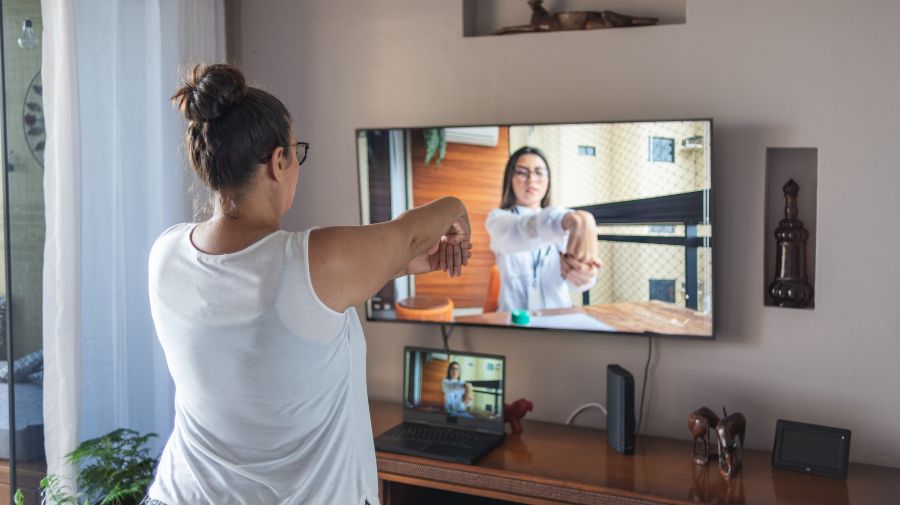Is your rehab practice ready for the future? Take our quiz to find out

With all the shifts in the field lately, it can be hard to tell whether your practice is keeping pace or falling behind. From hybrid care to value-based models, it feels like every day brings a new challenge or opportunity. Is your practice and team ready for what’s next?
This quick quiz will help you assess your readiness, spot gaps, and get practical ideas to stay ahead in this rapidly changing industry.
1. How equipped is your practice for hybrid care?
Clients expect flexibility, and hybrid care (a mix of in-person and virtual visits) is becoming standard practice.
Does your practice offer virtual and in-person sessions?
a. We already offer a combination of in-person and virtual visits, with seamless workflows in place.
b. We’ve dabbled in telehealth, but our systems and training need improvement.
c. What’s hybrid care?
If hybrid care isn’t a strength yet, don’t worry. Start small by integrating telehealth for specific client populations or services that could benefit the most. Invest in user-friendly tools that work well with your current systems and make training your team a priority to ensure confidence in delivering virtual care.
2. Do you use data to guide care decisions?
Tracking outcomes and using data effectively can improve both care quality and operational efficiency.
What best describes your practice?
a. We monitor client progress and use the data to tweak treatment plans regularly.
b. We collect some data, but it’s not consistently analyzed or applied.
c. Data seems overwhelming, and we’re not sure how to get started.
Feeling stuck when it comes to data? Begin with manageable steps. Try using your electronic health record (EHR) system to to track just one metric, like goal progression and build from there. Or, start attending trainings to better understand your software’s data analysis capabilities, and how to best leverage it as a team. Small progress can lead to big improvements in both tailoring care and preparing for future payer requirements.
3. Are you prepared for evolving payer models?
Unlike traditional fee-for-service models that reward volume, value-based care (VBC) shifts the focus to outcomes. Reimbursements are increasingly tied to the quality of care and client health improvements.
How prepared do you feel?
a. We track outcomes and submit payer reports that align with new models.
b. We’re aware of value-based care but haven’t built systems around it yet.
c. We mainly focus on traditional fee-for-service reimbursements, and/or don’t really understand value-based care.
If this feels like unfamiliar territory, now’s a good time to build knowledge. Value-based care can seem complex, but breaking it down helps. Start by familiarizing staff with the concept and collaborating on ways to document client outcomes. Simple processes like tracking treatment success rates or health improvements over time can help align your practice with this model. Staying updated through webinars or industry publications will also ensure your practice stays agile as payer expectations continue to shift.
4. Is your practice client-centered?
Client expectations are evolving with the field. Today, highly personalized and collaborative care isn’t just preferred; it’s expected.
How does your practice measure up?
a. Clients have access to clear treatment plans, goal-setting happens collaboratively, and feedback is built into our standard care.
b. We try to focus on clients’ goals but don’t have a consistent approach for personalization or collecting feedback.
c. Our care is clinician-guided, with limited input or customization based on specific client needs or preferences.
You might be thinking b or c sound more like your current situation. If that’s the case, consider creating more opportunities for clients to provide feedback and collaborate in their care.
Start by working with clients to create clear treatment goals during sessions. Use each appointment as a chance to review progress and adjust goals to stay aligned with what matters most to the client. Make sure these goals and any progress updates are documented in a way that’s easy for both clinicians and clients to understand.
Technology can also play a crucial role here. Tools like secure messaging apps, client portals, and telehealth platforms empower clients to stay connected, review their plans, and take an active role in their care.
Even small changes, like showing clients a visual breakdown of their progress or reviewing their goals together regularly, can build trust and make care feel more collaborative.
5. Are you proactive about preventing burnout?
Therapist burnout is on the rise, fueled by rising client loads, administrative stress, and evolving demands. Not only does burnout affect individual therapists; it contributes to staffing shortages, creating a cycle that further strains remaining staff.
What steps is your practice taking?
a. We have systems and workflows aimed at reducing admin burdens, provide mental health resources, and promote work-life balance.
b. We’ve tried to implement some support systems but don’t have a strong strategy in place.
c. Burnout feels like an unavoidable part of our work environment.
If a is where you’d like to be, and you’re not quite there yet, start with staff input. Where do they feel the most strain? Are documentation requirements taking up valuable time? Could automation in billing or client intake reduce the load? Focusing on small changes, like simplifying workflows or offering flexibility in scheduling, can make a big difference. Keeping your staff energized and supported is essential for providing high-quality care to clients.
6. Is your technology helping or holding you back?
Smart, up-to-date technology isn’t just about convenience; it can improve efficiency, support care insights, and reduce stress for your team.
How does your tech stack up?
a. Our tech is modern, with excellent functionality and support for hybrid care and data insights.
b. We use what works but could benefit from updates.
c. Our tech feels outdated and slows us down.
If your tech could use a boost, focus on gradual upgrades. Begin by identifying the tools that create the biggest bottlenecks or frustrations. Consider updating your EHR system, exploring features like automated documentation and data analysis, or looking for platforms that simplify your administrative workflows.
Beyond your EHR, look into tools like telehealth, payment processing, and revenue cycle management – designed to offer more flexibility with less stress.
Investing in better tools now can save time, improve satisfaction for both clients and staff, and ensure your practice is ready for growth.
What forward-thinking practices are doing
If this quiz surfaced areas to work on, you’re not alone. The most successful practices aren’t perfect, they’re proactive. Healthcare will keep evolving—sometimes in unpredictable ways. But by staying flexible and taking small, steps, your practice can thrive in the years ahead.
How ready are you for what’s next?






